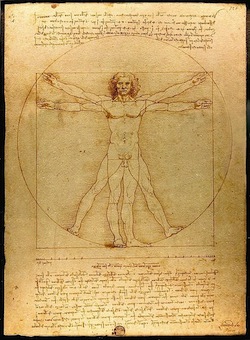
Unit 2: How Trade and Travel Changed the World
Lesson F: Renaissance and Reformation
Lesson Overview
Many historians see the end of European feudalism and transition from the late Medieval Period as the beginning of "Modern" world history. Technological and political changes contributed to this shift, especially in European society. Travel and trade increased, as did the exchange of ideas between cultures. The challenge to traditional church values sparked by the Reformation and explosion of cultural expression known as the "Renaissance" reflected the social, political, and economic transformations of the early Modern Period.

Renaissance Artist Leonardo Da Vinci's "Vitruvian Man" [1]
Key Questions
- How and why did trade and interaction lead to changes in political, economic, and social systems?
- What factors contributed to the establishment, expansion, and decline of empires?
- How did geography and location significantly impact events in history?
Student Outcomes
- Analyze the political, philosophical, and cultural contributions of classical Greece, Rome, Han China, and Islamic civilizations to the Renaissance.
- Describe the scientific, aesthetic, and cultural significance of major changes in painting, sculpture, literature, and architecture throughout Europe.
- Explain the role of new technologies, such as the printing press, on the spread of secular ideas and humanistic thought of the 14th through 17th centuries.
- Analyze the causes and consequences of discontent with the late medieval church during the Protestant and Roman Catholic Reformations.
- Identify the author or source of a historical document and explain the literal meaning of the document. (Historical Thinking Skill)
- Analyze change or continuity in areas of the world over time based on text and non-text information. (Historical Thinking Skill)
Key Terms
Student Resources
- The Classical Roots of the Renaissance Graphic Organizer (doc)
- The Changes of the Renaissance Graphic Organizer (doc)
- The Changes of the Renaissance Brief Constructed Response (doc)
- Historical Investigation — The Original Renaissance Man (doc)
- The Changes of the Reformation Brief Constructed Response (doc)
Chart of Activities
| Activities to Complete | Estimated Time |
|---|---|
| Pre-Assessment | 5 minutes |
| Key Terms | 5 minutes |
| Activator: The World 1300-1550 | 5 minutes |
| Opening: The European "Rebirth" | 10 minutes |
| Activity 1: A Classical Rebirth | 5 minutes |
| Activity 2: The Classical Roots of the Renaissance | 10 minutes |
| Activity 3: Rebirth of European Art | 15 minutes |
| Activity 4: Renaissance Man | 10 minutes |
| Activity 5: Evaluating the Renaissance | 15 minutes |
| Activity 6: Spreading the Word of Rebirth and Reform | 15 minutes |
| Activity 7: Reforming the Church | 5 minutes |
| Activity 8: Impact of the Reformation | 10 minutes |
| Activity 9: Reformation Cause and Effect | 5 minutes |
| Review | 5 minutes |
| Assessment | 5 minutes |
| Lesson Summary | 5 minutes |
Lesson Completion Time
The total estimated time to complete this lesson is 130 minutes.
Page Notes:
[1] Source: This image from http://en.wikipedia.org/wiki/File:Uomo_Vitruviano.jpg is in the public domain because its copyright has expired.

